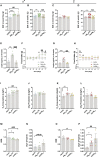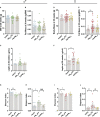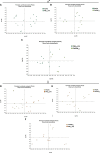Maternal exposure to air pollution alters energy balance transiently according to gender and changes gut microbiota
- PMID: 37082122
- PMCID: PMC10112381
- DOI: 10.3389/fendo.2023.1069243
Maternal exposure to air pollution alters energy balance transiently according to gender and changes gut microbiota
Abstract
Introduction: The timing of maternal exposure to air pollution is crucial to define metabolic changes in the offspring. Here we aimed to determine the most critical period of maternal exposure to particulate matter (PM2.5) that impairs offspring's energy metabolism and gut microbiota composition.
Methods: Unexposed female and male C57BL/6J mice were mated. PM2.5 or filtered air (FA) exposure occurred only in gestation (PM2.5/FA) or lactation (FA/PM2.5). We studied the offspring of both genders.
Results: PM2.5 exposure during gestation increased body weight (BW) at birth and from weaning to young in male adulthood. Leptin levels, food intake, Agrp, and Npy levels in the hypothalamus were also increased in young male offspring. Ikbke, Tnf increased in male PM2.5/FA. Males from FA/PM2.5 group were protected from these phenotypes showing higher O2 consumption and Ucp1 in the brown adipose tissue. In female offspring, we did not see changes in BW at weaning. However, adult females from PM2.5/FA displayed higher BW and leptin levels, despite increased energy expenditure and thermogenesis. This group showed a slight increase in food intake. In female offspring from FA/PM2.5, BW, and leptin levels were elevated. This group displayed higher energy expenditure and a mild increase in food intake. To determine if maternal exposure to PM2.5 could affect the offspring's gut microbiota, we analyzed alpha diversity by Shannon and Simpson indexes and beta diversity by the Linear Discriminant Analysis (LDA) in offspring at 30 weeks. Unlike males, exposure during gestation led to higher adiposity and leptin maintenance in female offspring at this age. Gestation exposure was associated with decreased alpha diversity in the gut microbiota in both genders.
Discussion: Our data support that exposure to air pollution during gestation is more harmful to metabolism than exposure during lactation. Male offspring had an unfavorable metabolic phenotype at a young age. However, at an older age, only females kept more adiposity. Ultimately, our data highlight the importance of controlling air pollution, especially during gestation.
Keywords: PM2.5; air pollution; gestation; gut microbiota; inflammation; metabolic program; obesity; particulate matter.
Copyright © 2023 Zordão, Campolim, Yariwake, Castro, Ferreira, Santos, Norberto, Veras, Saad, Saldiva, Kim and Prada.
Conflict of interest statement
The authors declare that the research was conducted in the absence of any commercial or financial relationships that could be construed as a potential conflict of interest.
Figures





Similar articles
-
Timing determines programming of energy homeostasis by maternal PM2.5 exposure in mouse models.Environ Pollut. 2024 Dec 15;363(Pt 2):125187. doi: 10.1016/j.envpol.2024.125187. Epub 2024 Oct 23. Environ Pollut. 2024. PMID: 39454811
-
Programming of mouse obesity by maternal exposure to concentrated ambient fine particles.Part Fibre Toxicol. 2017 Jun 23;14(1):20. doi: 10.1186/s12989-017-0201-9. Part Fibre Toxicol. 2017. PMID: 28645299 Free PMC article.
-
Short-term exposure to air pollution (PM2.5) induces hypothalamic inflammation, and long-term leads to leptin resistance and obesity via Tlr4/Ikbke in mice.Sci Rep. 2020 Jun 23;10(1):10160. doi: 10.1038/s41598-020-67040-3. Sci Rep. 2020. PMID: 32576879 Free PMC article.
-
Air pollution and children's health-a review of adverse effects associated with prenatal exposure from fine to ultrafine particulate matter.Environ Health Prev Med. 2021 Jul 12;26(1):72. doi: 10.1186/s12199-021-00995-5. Environ Health Prev Med. 2021. PMID: 34253165 Free PMC article. Review.
-
Predisposed obesity and long-term metabolic diseases from maternal exposure to fine particulate matter (PM2.5) - A review of its effect and potential mechanisms.Life Sci. 2022 Dec 1;310:121054. doi: 10.1016/j.lfs.2022.121054. Epub 2022 Oct 10. Life Sci. 2022. PMID: 36228772 Review.
Cited by
-
Air pollution accelerates the development of obesity and Alzheimer's disease: the role of leptin and inflammation - a mini-review.Front Immunol. 2024 Jun 12;15:1401800. doi: 10.3389/fimmu.2024.1401800. eCollection 2024. Front Immunol. 2024. PMID: 38933275 Free PMC article. Review.
-
PM2.5, component cause of severe metabolically abnormal obesity: An in silico, observational and analytical study.Heliyon. 2024 Apr 3;10(7):e28936. doi: 10.1016/j.heliyon.2024.e28936. eCollection 2024 Apr 15. Heliyon. 2024. PMID: 38601536 Free PMC article.
-
The relationship between prenatal drought exposure and the diversity and composition of gut microbiome in pregnant women and neonates.Sci Rep. 2025 Jan 2;15(1):296. doi: 10.1038/s41598-024-82148-6. Sci Rep. 2025. PMID: 39747960 Free PMC article.
-
Association Between Exposure to Particulate Matter Air Pollution with Risk of Obesity Among Children and Adolescents in Northern and Central Taiwan.Children (Basel). 2024 Dec 19;11(12):1545. doi: 10.3390/children11121545. Children (Basel). 2024. PMID: 39767974 Free PMC article.
-
Perinatal Hypoxia and Immune System Activation in Schizophrenia Pathogenesis: Critical Considerations During COVID-19 Pandemic.Physiol Res. 2024 Nov 29;73(S2):S615-S639. doi: 10.33549/physiolres.935501. Physiol Res. 2024. PMID: 39589306 Free PMC article. Review.
References
-
- Jiwani SS, Carrillo-Larco RM, Hernández-Vásquez A, Barrientos-Gutiérrez T, Basto-Abreu A, Gutierrez L, et al. . The shift of obesity burden by socioeconomic status between 1998 and 2017 in Latin America and the Caribbean: A cross-sectional series study. Lancet Glob Health (2019) 7(12):e1644–54. doi: 10.1016/S2214-109X(19)30421-8 - DOI - PMC - PubMed
-
- NCD Risk Factor Collaboration (NCD-RisC)—Americas Working Group . Trends in cardiometabolic risk factors in the americas between 1980 and 2014: A pooled analysis of population-based surveys. Lancet Glob Health (2020) 8(1):e123–33. doi: 10.1016/S2214-109X(19)30484-X. Erratum in: Lancet Glob Health. 2020 8(5):e648. Erratum in: Lancet Glob Health . 2021 9(1):e23. - DOI - PMC - PubMed
Publication types
MeSH terms
Substances
LinkOut - more resources
Full Text Sources
Medical
Miscellaneous

